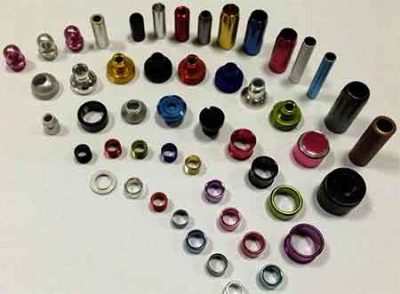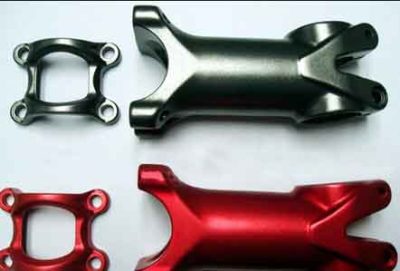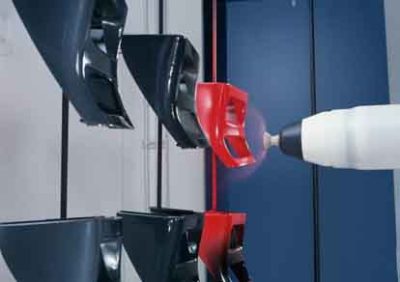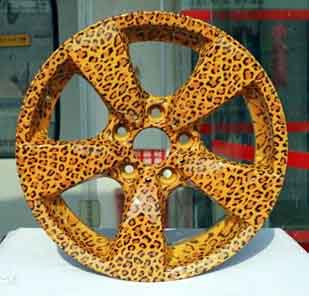Surface treatment is a process of artificially forming a surface layer on the surface of the prototype material that is different from the mechanical, physical and chemical properties of the substrate. Formålet med overfladebehandling er at imødekomme produktets korrosionsbestandighed, Modstandsdygtighed, dekoration eller andre særlige funktionelle krav. For metal and plastic prototypes, our commonly used surface treatment methods are:
Mechanical polishing, chemical treatment, surface heat treatment, spray surface. Surface treatment is to clean, sweep, deburr, degrease, and deoxidize the surface of the prototype workpiece.

Overfladebehandling af CNC bearbejdede dele

Plastic spraying of hardware products
1. Phosphating:
Phosphating is the process of treating the metal surface with an orthophosphate solution of manganese, zink, iron and other metals to form an insoluble phosphate protective film. The protective film formed after the phosphating treatment can improve the insulation and corrosion resistance of the metal, forbedre beskyttelses- og dekorationsydelsen af prototype-emnet, og kan også bruges som et godt bundlag af belægningen. Metaloverfladefosfateringsmetoderne er opdelt i koldfosfatering (normal temperatur fosfatering), termisk fosfatering, sprøjtefri fosfatering og elektrokemisk fosfatering. Fosfatbehandling i bilindustrien er den vigtigste metode til forbelægning af malede dele såsom bilpaneler, førerhuse, og bagagerumspaneler. Fosfatfilmen skal være fin, glat, uniform, moderat i tykkelse, og har en vis varmebestandighed.

Injektion af metalprodukter
2. Sandblæsning:
Den bruger trykluft som kraft til at danne en højhastighedsstrålestråle til at sprøjte sprøjtematerialet (kobberåre, kvartssand, smergel, jernsand, hav sand) på overfladen af emnet, der skal bearbejdes ved høj hastighed. På grund af slibemidlets slag og skærende virkning på overfladen af emnet, overfladen af emnet opnår en vis grad af renhed og forskellig ruhed. De mekaniske egenskaber af overfladen af emnet er forbedret, hvorved arbejdsemnets udmattelsesmodstand forbedres, forøgelse af vedhæftningen mellem emnet og sprøjtebelægningen, forlænger malingsfilmens holdbarhed, og også befordrende for udjævning og dekoration af malingen.
3. Sprøjtning:
Overflademaling er en af de mest udbredte overfladeprocesser. Sprøjtning har følgende fordele:
(1) Det kan dække overfladedefekterne på emnet efter formning;
(2) Overfladen af emnet kan sprøjtes for at opnå en række forskellige farver, forskellig glans, different appearance and visual effects and a variety of different hand feelings;
(3) Enhance the hardness and scratch resistance of the workpiece surface;
The effects of spraying are:
Matte, semi-matte, gloss (højglans). Various colors, various textures, etchings, drawing effects (metal color can only be used for drawing), leather effects, elastic feel effects (rubber paint), etc.
Surface treatment process-spraying
4. Wire drawing:
Wire drawing is a surface treatment method that forms lines on the surface of the workpiece by grinding the product to achieve a decorative effect. Wire drawing can well reflect the texture of metal materials, and can make the metal surface obtain a non-mirror-like metallic luster. According to different surface effects, it can be divided into straight wire (hairline pattern) and chaotic wire (snow pattern).
Kvaliteten af silkemønster er meget subjektiv. Hver bruger har forskellige krav til overfladelinjer og forskellige præferencer til linjelinjer. Derfor, det er nødvendigt at have en trådtræksmodel for at behandle de tilfredsstillende resultater, som brugerne kan lide. Cirkulær bue (skæringspunktet mellem bue og lige ansigter er meget grimt og vil tegne ujævnt).
5. Plastsprøjtning (støvsprøjtning):
Elektrostatisk sprøjtning bruger fænomenet koronaudladning til at få pulverbelægningen til at adsorbere på emnet. Processen er sådan: Pulverbelægningen sendes til sprøjtepistolen af pulverforsyningssystemet med trykluftgas, og højspændingen genereret af den højspændings elektrostatiske generator tilføjes til forenden af sprøjtepistolen. På grund af coronaudledning, en tæt ladning genereres i nærheden af den. When the powder is ejected from the gun nozzle, it forms charged paint particles. It is attracted to the workpiece with the opposite polarity under the action of electrostatic force. As the amount of powder sprayed increases, the charge builds up. When it reaches a certain thickness, due to the electrostatic repulsion, the adsorption will not continue, so that the entire workpiece can obtain a certain thickness of powder coating. Then the powder is melted, leveled and solidified by heat, det er, a hard coating film is formed on the surface of the workpiece.
Advantages and disadvantages of electrostatic spraying:
No need for thinner, no poison, no pollution, good coating quality, very high adhesion and mechanical strength, korrosionsbestandighed, short curing time, no primer, low technical requirements for workers, and high powder recycling rate;
But the coating is very thick, the surface effect is corrugated, not smooth, and it can only process the two appearance effects of semi-matte and bright.

Curved printing
6. Printing:
(1) Silk screen:
Disadvantages of silk screen: Screen printing mesh portion permeable to ink, stencil onto a substrate; The rest of the mesh on the printing plate is blocked and cannot penetrate the ink, forming a blank omission on the substrate. The mesh of the part where the ink is to be used on the printing plate is not closed, and the ink penetrates during printing, forming ink marks on the substrate. When printing, pour the ink into one end of the screen printing plate, and the ink will not leak on the substrate through the mesh without external force. When the ink is scraped with a squeegee at a certain inclination angle and pressure, the ink is transferred to the substrate under the screen through the screen, so as to achieve image reproduction. (The printed pattern is raised)
The advantages of silk screen printing:
EN. Low cost and quick results.
B. Suitable for printing on irregular substrate surface.
C. Strong adhesion and good ink adhesion.
D. Thick ink layer and strong three-dimensional effect.
E. Rotation resistance, strong optical rotation and good color forming.
F. Wide range of printing materials and large printing area.
(2) Pad printing (curved printing):
Refers to using a piece of flexible rubber to print the characters and patterns that need to be printed on the surface of a plastic molded product with curved or slightly concave and convex surfaces. In pad printing, the ink is first put into an intaglio plate with engraved characters or patterns, and then the characters or patterns are copied onto rubber, and then the rubber is used to transfer the characters or patterns to the surface of the plastic molded product. Endelig, the ink is cured by heat treatment or ultraviolet light irradiation.
Surface treatment process-curved printing
7. Laser carving:
Laser carving is a process of surface treatment using optical principles. For eksempel, to make a keyboard, the words on it are blue, green, red and gray, and the keys are white. When laser engraving, first spray oil, blue, green, red, and gray with the corresponding color, so it looks like there are blue keys, green keys, etc., and then spray a layer of white as a whole. This is a whole white keyboard, and the blue and green are all wrapped underneath. Brug derefter laserteknologien og knapkortet indsendt af industridesigneren til at lave filmen, skåret den hvide olie ud på den, og de blå og grønne knapper vises.
Begrænsninger ved laserudskæring:
(1) Laserskæringsdybde:
Aluminium er 0,1 mm, plast spraymaling belægning: 0.2-0.3mm, jern og andre metaller er op til 0,08 mm;
(2) Grænseoverfladearealet for laserudskæring er:
100X100 mm, mere end 100X100 mm skal splejses lasergravering, placeringen af forbindelsen er ikke smuk, og forbindelsessporet er mere tydeligt.
(3) Hvide og næsten hvide farver kan ikke fjernes ved lasergravering, og tegnene indgraveret med laser på den buede overflade er tilbøjelige til at deformeres.
 English
English العربية
العربية 中文(漢字)
中文(漢字) Čeština
Čeština Dansk
Dansk Nederlands
Nederlands Suomi
Suomi Français
Français Deutsch
Deutsch Italiano
Italiano 日本語
日本語 ಕನ್ನಡ
ಕನ್ನಡ 한국어
한국어 Português
Português Русский
Русский Slovenčina
Slovenčina Español
Español Svenska
Svenska Türkçe
Türkçe

